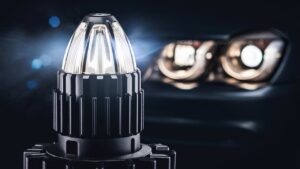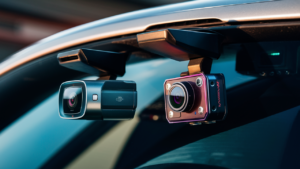When it comes to upgrading your car’s headlights, you may be wondering whether to go for HID Headlights or LED (Light Emitting Diode) lights. Both options have their pros and cons, and the choice ultimately comes down to personal preference and the needs of your vehicle. In this post, we’ll compare HID headlights and LED headlights to help you decide which is the better choice for your car.
Recommended Best HID Headlights 2024-2025
| Recommendation | Product |
| Best Overall | AUXITO 9005/HB3 H11/H8/H9 LED Bulbs |
| Popular Choice | Sinoparcel D1S Xenon HID Headlight |
| Best Value | DMEX D3S HID Headlight Bulbs |
| Best Budget | Torchbeam D3S HID Headlight Bulb |
| Another Excellent Pick | FAHREN H13/9008 LED Bulbs |
What are HID headlights?
HID headlights are a type of high-intensity discharge lighting that use a ballast to ignite an arc of electricity between two electrodes within a gas-filled bulb. This arc produces a bright, white light that is much brighter than traditional halogen headlights. HID headlights have been around since the 1990s and are still a popular choice for many car owners today.
Pros of HID headlights
- HID headlights are much brighter than halogen headlights, providing better visibility at night and in bad weather conditions.
- They have a longer lifespan than halogen headlights, lasting up to 2,000 hours compared to 500-1,000 hours for halogen.
- HID headlights have a wider beam pattern, providing better illumination of the road ahead.
Cons of HID headlights
- HID headlights are more expensive to purchase and install than halogen headlights.
- They require a warm-up time before reaching full brightness, which can be a problem for some drivers.
- HID headlights are not as energy-efficient as LED headlights, which can lead to a drain on your car’s battery.
What are LED headlights?
LED headlights use light-emitting diodes to produce light. These diodes are small, energy-efficient, and produce very little heat. LED headlights have been around since the early 2000s and are becoming increasingly popular as a replacement for traditional halogen and HID headlights.
Pros of LED headlights
- LED headlights are more energy-efficient than HID headlights, using less power and putting less strain on your car’s battery.
- They have a longer lifespan than HID and halogen headlights, lasting up to 30,000 hours or more.
- LED headlights produce a brighter, more natural-looking light than HID headlights.
Cons of LED headlights
- LED headlights are more expensive to purchase and install than halogen headlights.
- They can produce a glare that may be distracting to other drivers on the road.
- LED headlights have a more focused beam pattern, which may not provide as much coverage of the road ahead.

Which is the better choice for your car?
The choice between HID headlights and LED headlights comes down to personal preference and the needs of your vehicle. If you’re looking for the brightest, most powerful headlights and don’t mind paying a little extra, HID headlights may be the better choice. If you’re looking for a more energy-efficient option with a longer lifespan, LED headlights are the way to go.
Ultimately, the choice between HID headlights and LED headlights is up to you. Consider the pros and cons of each option, as well as your own budget and driving needs, before making a decision.
HID Headlights for Cars: Boost Your Night Vision
HID headlights for cars are brighter than standard headlights, containing an HID light bulb with two electrodes encased in a glass enclosure filled with xenon gas and metal salts. These headlights offer increased visibility and a modern look to vehicles, making them a popular choice for car enthusiasts.
HID headlights, short for high-intensity discharge, are a type of headlight that provides brighter illumination compared to standard halogen bulbs. They are equipped with a gas-filled bulb that produces light when an electric current passes through it. HID headlights are known for their efficiency and longevity, making them a desirable option for many car owners.
Additionally, they offer a distinct appearance that enhances the overall aesthetic of a vehicle. As a result, they have become a sought-after upgrade for those looking to improve their car’s lighting performance and style.
The Basics Of Hid Headlights
Upgrade your car with HID headlights for enhanced brightness and visibility on the road. HID lights feature high-intensity discharge bulbs that emit a powerful light beam, improving your driving experience at night. Experience the benefits of HID technology for a safer and more stylish ride.
| What HID Means | HID stands for High-Intensity Discharge. It is a type of headlight that uses an electrical charge to ignite a gas (xenon gas) and metal salts to produce light. HID headlights are much brighter and efficient than traditional halogen headlights, producing more light with less power. |
| Xenon Gas and Metal Salts | The HID light bulb consists of two electrodes encased in a glass enclosure. This enclosure is filled with xenon gas and metal salts. When an electrical charge is applied to the bulb, it ionizes the gas and metal salts, producing a bright, white light. HID headlights provide better visibility on the road and are a popular choice for car enthusiasts. |
HID headlights have become increasingly popular due to their brightness and efficiency. They use an electrical charge to ignite a gas (xenon gas) and metal salts to produce light. HID stands for High-Intensity Discharge, and these headlights are much brighter than traditional halogen headlights. The HID light bulb consists of two electrodes encased in a glass enclosure filled with xenon gas and metal salts. When an electrical charge is applied to the bulb, it produces a bright, white light. HID headlights provide better visibility on the road and are a popular choice for car enthusiasts.
Benefits Of Upgrading To Hid
|
Upgrading to HID headlights for cars offers enhanced night visibility on the roads. The energy efficiency of HID lights results in longevity compared to traditional halogen bulbs. |
Comparing Headlight Options
HID vs Halogen: HID headlights are brighter due to high-intensity discharge, while halogen lights are standard. HID bulbs contain xenon gas and metal salts.
HID vs LED: LED headlights are energy-efficient and durable, whereas HID lights are brighter but less energy-efficient. LED lights offer a longer lifespan compared to HID bulbs.
Installation Of Hid Headlights
When installing HID headlights, choose a kit that is compatible with your car model. Check the color temperature and brightness of the bulbs to ensure they meet your requirements. Follow the manufacturer’s instructions carefully for a successful installation.
Before beginning the installation, ensure that the vehicle’s battery is disconnected to prevent any electrical mishaps. Carefully remove the existing headlights and install the new HID bulbs. Take your time to properly position the bulbs and secure them in place.
After installing the bulbs, connect the wiring harness and test the headlights to ensure they are working correctly. Adjust the headlight beams if necessary to prevent blinding oncoming drivers.
Legal Considerations
When considering HID headlights for cars, it’s important to be aware of the legal considerations. HID headlights are brighter than standard headlights, but they may cause glare for other drivers, which could lead to safety concerns and potential legal issues.
It’s crucial to ensure that HID headlights are installed properly and comply with local regulations to avoid any legal repercussions.
| Legal Considerations |
| Road Safety Regulations |
| When considering HID headlights for cars, it’s crucial to be aware of the state-specific laws governing their usage. Certain states have regulations regarding the color and brightness of headlights to ensure road safety. It’s important to review the guidelines in your state to avoid any potential legal issues. |
Potential Drawbacks
|
Cost Analysis
Upgrade your car with HID headlights for enhanced brightness and visibility. Conduct a cost analysis to compare prices and find the best deal for your vehicle’s specific make and model.
Real-world Experiences
HID headlights are becoming more and more popular among car enthusiasts due to their brightness and energy efficiency. Many users have testified to the benefits of HID headlights, claiming that they provide better visibility and enhance the overall look of their car. Some users have even reported that HID headlights have helped them avoid accidents on the road.
Expert recommendations suggest that if you are considering installing HID headlights in your car, it is important to choose a reputable brand and to have them installed by a professional. Aftermarket HID conversion kits can be used to install HID bulbs on almost any vehicle, but it’s not as simple as just changing out your old bulbs for new ones.
It is important to note that there are some disadvantages to HID headlights, such as the brightness of the lights in the rearview mirrors which can cause a problem for drivers in front of your vehicle. However, the benefits of HID headlights outweigh the disadvantages for many car owners.
Overall, HID headlights are a great option for those looking to improve the visibility and appearance of their car. It is important to do your research and choose a reputable brand and installer to ensure the best results.
Frequently Asked Questions
Are Hid Headlights Better Than Led Lights?
HID headlights offer brighter light, but LED lights are more energy-efficient and durable.
How Do Hid Headlights Compare To Leds In Terms Of Lifespan?
HID headlights typically last around 2,000 hours, while LED lights can last up to 20,000 hours.
Can I Easily Convert Hid Headlights To Led?
Converting HID headlights to LED may require additional components and adjustments for compatibility.
Do Hid Headlights Produce More Heat Than Leds?
HID headlights generate more heat than LEDs, which can potentially affect surrounding components.
Conclusion
Both HID headlights and LED headlights have their advantages and disadvantages. HID headlights provide a brighter light and wider beam pattern, while LED headlights are more energy-efficient and have a longer lifespan. The choice between the two ultimately comes down to your personal preference and the needs of your vehicle. Whatever you choose, make sure to choose a reputable brand and have your headlights installed by a professional to ensure the best performance and safety on the road.








